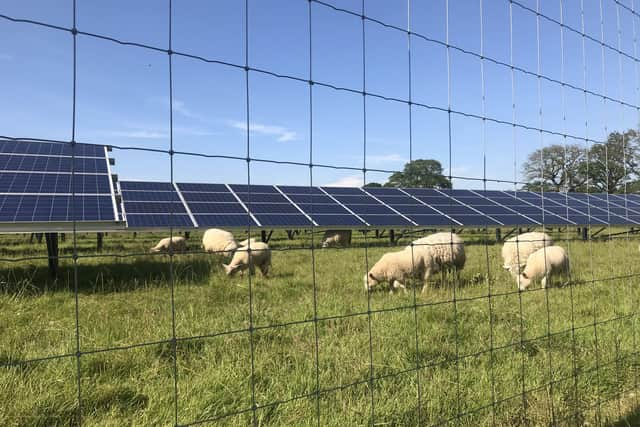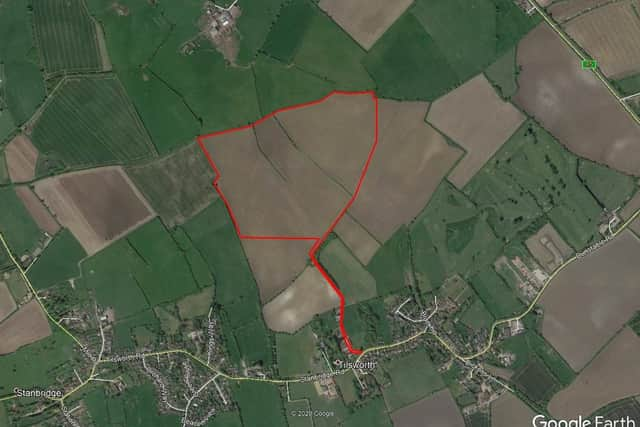Application to be submitted for large solar farm near Leighton Buzzard
and live on Freeview channel 276
Danish company European Energy, which has British headquarters in Glasgow, is preparing to submit a planning application to Central Bedfordshire Council for land north of Tilsworth.
It is hoping to occupy 65 acres of land at Trinity Hall Farm to generate power for the National Grid.
Advertisement
Advertisement
However, the news has received mixed reactions from the public, who have been sent information packs about the scheme, with some residents welcoming green energy on their doorstep instead of housing, while others feel that its construction could cause traffic problems and that the panels will be an eyesore.


Central Bedfordshire councillor Mark Versallion told the LBO: “I’m certainly very keen on renewable energy and very supportive, but when it comes down to the planning, the devil is in the detail.
“From my perspective, my job is to reflect the concerns and interests of the villagers.
“Firstly, it would involve giving up fields on the Green Belt. Do we get anything in return? Surely, it’s better to build on a brownfield site?
Advertisement
Advertisement
“Secondly, there’s construction traffic driving through Tilsworth and Stanbridge. They propose to go along the A5, then up into Stanbridge and then north to Tilsworth. Some of the [residents’] windows already shake when buses go through. This will exacerbate that.”


Cllr Versallion also pointed out the argument that Britain should not be getting rid of farm land because it is claimed that countries could become more vulnerable if they don’t grow more food of their own.
Reflecting the mix of views, he added: “It’s difficult for people who live in the countryside, because they want to live in the countryside - they want to look out and see green fields.
“Others would rather have 65 acres of panels than houses.
“Part of my job would be to negotiate something in return. It [the power] would just go into the National Grid. Perhaps it could be cheaper electricity bills for the community?”
Advertisement
Advertisement
A European Energy spokesman, said: “European Energy’s UK subsidiary (EE) is consulting on its Trinity Hall Solar Farm proposals to generate 18 megawatts of clean power sufficient to power the equivalent of over 5,000 homes annually.
“The renewable electricity project will connect directly to the existing 33,000-volt overhead power line via underground cable. The solar farm will be constructed over a three to four month period and some local residents have expressed concern about traffic impacts on local roads from HGVs delivering materials to the site.”
Adam Spearey, EE’s project director, said: “Our consultation on traffic and transport is open now and we welcome all feedback to ensure disruption is minimised. Mitigation measures suggested so far include restricted hours for deliveries, condition surveys before and after construction and ongoing liaison with community representatives during the works.”
He said during the proposed 30-year operation, the solar farm would significantly reduce the present number of agricultural vehicle movements using the local roads.
Advertisement
Advertisement
With Trinity Hall Farm currently harvesting biomass on the site – due to it not being classified as the best or most versatile agricultural land – there are 392 tractor movements through the village per year. By switching to solar power production, Mr Spearey said tractor-related movements would reduce to an estimated 177 per year.
He said: “The cost of improving public rights of way, viewing platforms, new wildlife habitat, amenity areas, species rich grasses, new native trees and hedges and livestock grazing will be met entirely by EE. These improvements for people, wildlife and climate to the Green Belt are central to the project’s offering. We have requested meetings with the local parish councils as we recognise that they are best placed to advise on local needs concerning community benefits.
“It is exceptional to find an area of land suitable for solar panels so close to a suitable grid connection point and these circumstances make this location ideal to minimise works as well as presenting a natural opportunity to enhance the Green Belt.”
EE anticipates submitting a planning application to Central Bedfordshire Council in Q4 2020 after consultation and environmental studies have been completed.
Send feedback to [email protected].